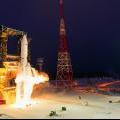
Khrunichev Press Release
Plesetsk Launch Site, Arkhangelsk Region, 23 December – The flight test of the newest the heavy-lift Angara A5.1L launch vehicle was successfully conducted today from the Plesetsk Cosmodrome.
The purpose of the test flight was to carry out comprehensive verification and demonstration of the Angara A5.1L launch vehicle readiness to loft geostationary spacecraft.
In accordance with the State Commission’s decision the lift-off of the maiden flight heavy-lift rocket named Angara A5.1L was performed at 08:57:25 Moscow time from the multi-purpose launch complex.
The Angara A5.1L integrated launch vehicle consists of the 3-stage Angara A5.1L launch vehicle based on the universal-design rocket modules (URM) and the Ascent Unit. The Ascent Unit includes the mass/size mockup of the satellite (simulated payload) stacked on the Breeze M upper stage under the payload fairing. The launch vehicle is powered by the engines utilizing environmental friendly propellants – oxygen and kerosene. The lift-off mass of the Angara A5.1L integrated launch vehicle is approximately 768 metric tons (MT), the mass of the payload is 2.04 MT.
Launch operations were conducted by the teams from the Russian Aerospace Defence Forces and Russian space industry.
Processing, lift-off and flight of the vehicle were reported to be nominal.
The launch was performed along the flight trajectory with inclination of 63.2 degrees. Separation of the Orbital Unit (including the Breeze M upper stage and the dummy satellite) from the 3rd stage of the launch vehicle was nominal. Further injection of the Orbital Unit into the target geostationary orbit was accomplished by the means of the Breeze M propulsion system. The Orbital Unit achieved the target orbit at the expected time, approximately 9 hours following the launch vehicle lift-off.
Per the mission design, no separation of the payload from the upper stage occurred. Upon reaching the target orbit, the Breeze M upper stage completed two maneuvers into the graveyard orbit.
See the video: https://www.federalspace.ru/21211/
###
GENERAL INFORMATION
Angara Space Rocket Complex
The Angara SRC is one of the top priorities to develop the national launch system based entirely and exclusively on the Russian research and industrial potential.
Development of the Angara SRC is a task of paramount importance to the Russian government. Implementation of the Angara SRC will allow Russia to launch spacecraft of all types from its own territory and will ensure that our country has a guaranteed and independent access to space.
The Russian Ministry of Defence and the Russian Space Agency are the state customers for the Angara SRC. The primary designer and manufacturer is the state-run Khrunichev Research and Production Space Center.
The Angara launch vehicle is designed on the basis of standard assortment of the light, medium and heavy-lift modules (URMs). The vehicle will be capable of injecting virtually the entire range of payloads to come into a required range of orbit altitudes and inclinations, including the geostationary one, making sure that Russia has a truly independent access to space.
Various configurations of the vehicle are implemented with the help of the universal-design rocket modules (URM) – one module for the light vehicle, three for the medium vehicle, and five for the heavy vehicle.
URMs underwent pilot testing as part of an experimental Angara 1.2PP lightweight vehicle. The successful launch of this vehicle in July 2014 kicked off the Angara SRC flight test program at the Plesetsk launch site.
In addition, a prototype of the Angara 1.2PP first stage (URM-1) passed flight tests as part of the first South Korean KSLV launch vehicle. Three missions of this vehicle were accomplished in 2009, 2010 and 2013 respectively.
Wide use of commonality and unique engineering solutions permit to launch the entire family of the Angara vehicles from the same launch pad.
Summary of Angara A5.1L Maiden Flight
The launch of the Angara A5.1L integrated launch vehicle (ILV) is performed from the Plesetsk launch site in order to inject the dummy payload into the target geostationary orbit.
The Angara A5.1L launch opens the flight test program of the Angara Space Rocket Complex (SRC) featuring the heavy-lift Angara A5 launch vehicle.
Description and Major Characteristics of Angara A5.1L Launch Vehicle
Angara A5.1L ILV includes Angara A5 LV and Ascent Unit (AU).
Angara A5 LV includes:
• Stage I booster including four strap-on boosters based on universal-design rocket modules (URM-1)
• Stage II booster based on a universal-design rocket module (URM-1)
• Stage III booster based on a universal-design rocket module (URM-2)
Ascent Unit includes:
• Breeze M Upper Stage
• Payload Fairing (PLF)
• Dummy Payload
ILV Mass at Lift-Off: ~ 768 MT
Mass of Dummy Payload: 2.04 MT
Number of LV Stages: 3
Propellants:
• LV: oxygen, kerosene
• Breeze M: nitrogen tetroxide, unsymmetrical monomethylhydrazine
Duration of LV Powered Flight: 735 seconds
Duration of Mission: ~ 9 hours.
Summary Mission Design
The Angara-A5.1L mission design comprises the following phases:
• Angara A5 injects the Orbital Unit (OU) including the Breeze M upper stage and the payload dummy into a suborbital trajectory
• Breeze M injects the OU into the target geostationary orbit (GSO)
• The OU is injected into the graveyard orbit
The LV is launched along the trajectory to a parking orbit with the inclination of 63.2 degrees. Drop zones for the Stage I, II and III boosters are located in the Komi Republic, Tomsk Region and the waters of the Philippine Sea respectively.
The PLF is jettisoned at the initial phase of Stage III operation. The PLF halves fall down in the Stage II drop zone.
The OU is injected into the GSO with a standard 9h mission design using four Breeze M main engine burns.
No separation of the dummy payload is performed in the target orbit.
